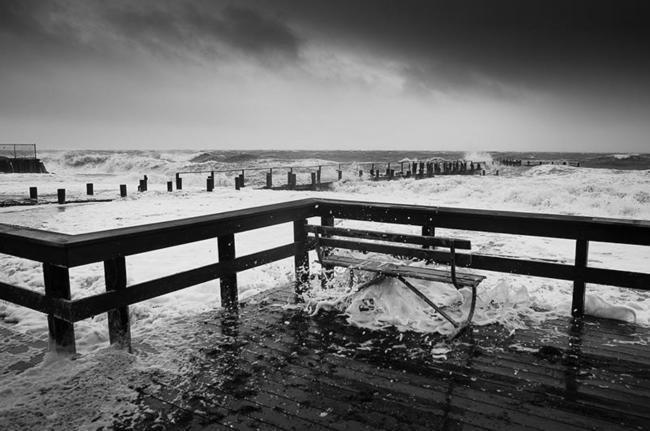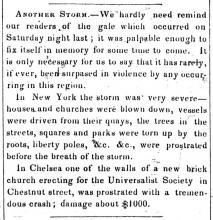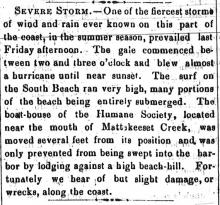High winds, high tides, and heavy rains battered the Island last night as hurricane Belle swept destruction across New England.
Packing winds 100 miles per hour or better and rainfall in excess of five inches, and traveling at 25 miles per hour, the hurricane was a powerhouse, even if it was little - only 75 miles across.
The Vineyard was braced for heavy damage, but as Islanders finally retired last night, they were unsure whether the Island was in for the worst drubbing it has seen since the one-two punch of hurricanes Carol and Edna in 1954, or nothing more than gale winds, torrential rains, and flood tides.
As hurricane Belle paused indecisively off New Jersey in the evening, feinting to the west and then heading east again, forecasters tried desperately to keep their reputation ahead of the storm’s rapidly-changing line of fire by issuing new guesses every quarter-hour.
When high clouds once again hid the full moon last night, the Vineyard’s temporary reprieve had been cancelled. Eight-foot tides were expected; but after a busy day, the Island was as ready as it could be made.
“What can you do but wait?” people remarked to one another, as they hurried home with armfuls of groceries, flashlights, and sterno cans. A sudden, but brief shower late in the afternoon brought jests that that was all there was to it; the attempt at levity was inspired - and belied - by an electric atmosphere of anxiety.
Steady lines of trailered boats moved inshore from every launching ramp and lift. From Dock street in Edgartown, goods of every sort - air conditioners, leather sandals, dinner dresses, and souvenirs - were carried toward higher ground. Civil defense officials began evacuation procedures.
At 5 p.m. yesterday 178-foot cruise ship Independence with 100 persons on board lost both engines just off Woods Hole. Fearful of laying to anchor in such an exposed berth during a hurricane, the captain asked for help from Woods Hole Coast Guard. The Point Bonita and Point Jackson were sent to her aid, and towed her into Woods Hole’s Great Harbor without further incident.
The tension has been mounting for days, ever since hurricane Belle was first reported off Florida, and headed this way. At that point, the routine speculation started.
Early Saturday night the sky showed signs of Nature’s growing temper. To the east, the full moon shone bright on scattered, confused cirrus clouds, sweeping toward the north. To the West, heavy cumulus swept low along the horizon, hiding a thunderstorm that let loose about 10:30 p.m.
Monday morning showed clearer skies, and the barometer rising ever so slightly to 30.12. The wind was only five or ten knots, out of the south, but it had an uncommon feel of restrained power to it. Aloft, a double layer of clouds showed, a wind sheer of 30 degrees or more.
Islanders arose to find two red flags with black centers flying from storm warning stations, and weather reports that Belle was scheduled to arrive here by 7 a.m. this morning.
The reports by then were of a small, but powerful, hurricane, 75 miles across, packing winds up to 125 miles per hour, increasing in intensity, and headed this way. As the day wore on the only change in the report was advancement of the arrival hour - by 3 p.m., the expected arrival was 7 to 12 hours away.
That put its arrival just about at the top of the tide down-Island, and on the night of the full moon to boot. The word passed around Edgartown was that some source had forecast tides five feet over Memorial Wharf.
The Island Civil Defense started evacuation preparations early in the morning. Refuge centers were set up at the Gay Head town hall, Chilmark Community Center, West Tisbury school, Oak Bluffs school, the regional school, and at parish houses in Edgartown. Word went out to campers at Webb’s Campground and the Martha’s Vineyard Family Campground to pack up bedding, water, and food, and start heading for those centers at 4 p.m.
From Lobsterville to Katama, police sent word out that residents of low-lying areas could seek shelter in the refuges. Police and fire departments prepared to provide transportation for the evacuees if things got bad.
At the hospital, Island civil defense director Frank Gibson Jr. was setting up a command center in a vacant room. From there, he was directing preparations to gird the Island — and to mop up the damage. Around him, workmen were securing loose signs, and removing things movable from the lawn around the building. Heavy drapes were pulled across all the hospital’s windows; a list of potential blood donors was readied, and all personnel were put on alert.
Governmental work consisted, for the most part, of preparing to clean up what damage should occur, but citizens were busy with preparations to minimize the damage, and to make themselves comfortable while the onslaught lasted.
What can you do but wait? Plenty.
The first worry was boats. A line of vessels seeking security in the Lagoon backed up traffic along the Beach road by holding the drawbridge open: by 9:30 a.m. 25 or 30 of them had holed up there. Small boat owners brought their vessels ashore, thinking the risk of a boat being crushed by a tree was smaller than being ripped off its mooring and dashed ashore. Crews on bigger boats began doubling up on moorings, rigging chafing gear, and removing gear of every sort. By noon, Machine and Marine reported it had sold out every piece of ground tackle and appurtenances thereto it had in stock, and the demand was still rising.
The probability of power failure was on everyone’s mind. Batteries, flashlights and camping stoves were sold in staggering quantities. Souvenir merchants found that those odd-ball candles they wished they hadn’t stocked suddenly vanished.
Hand pumps, long neglected, suddenly found themselves receiving some happy attention. In homes without those useful appliances, bathtubs were dedicated at cisterns, and every empty bottle was filled with drinking water.
A power failure would also still the Island springs of gasoline: lines at service stations rivaled those at the peak of the gasoline shortage.
At the telephone company office, preparations were being made for a dawn damage survey, and emergency power supplies for the few Island switchboards.
First thing in the morning, the early birds began stocking up for a few days of isolation. Grocery and liquor stores saw business equalled only by the Fourth of July. At the Edgartown Market, lines backed up to the fish counter; carts were loaded with perishables, canned goods, bags of charcoal, and every other manner of supply.
Suppliers of non-essentials found their stores deserted, and took advantage of the business calm before Nature’s storm to batten the hatches.
Shop windows were decorated as if for Halloween with tape to strengthen windows against the coming winds. Goods were moved off the floor; police warned of possible looting.
Alone low-lying Dock street in Edgartown, merchants went through their practiced drill of evacuation. Everything movable on the ground floor of the Seafood Shanty was being moved upstairs. Larry Levine, owner of the Village Fair, pushed a garment rack of dresses up the slope of Lower Main street to the Harborside Realty office; “I’m taking everything I can of the higher priced goods,” he said.
At Yankee Bazaar, owner Barbara Corliss packed her stock into cardboard boxes, and prepared to move it to her Yarn Shop, on higher ground. “I’ve been through it before,” she said. “I didn’t do anything until noon; then I went at it. My son asked me what if it doesn’t come — ‘then I move everything back,’ I told him.”
She wasn’t alone. Helping her pack was a woman who had walked in off the street, and, seeing the press of necessity, pitched in with vigor and enthusiasm.










Comments